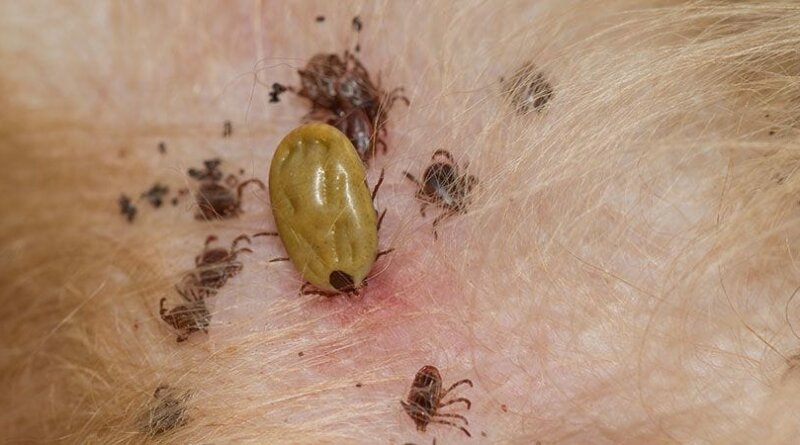Ticking Time Bombs: The Diseases Carried By Ticks
Odds are good that you will encounter a tick in the near future. And your dog has even better odds. After all, they spend a good portion of every day outside! Dogs are also prone to “off the trail” exploration.
Since humans aren’t as hairy as other mammals, we stand a better chance of noticing when a tick attaches. Dogs, on the other hand, are furry, and a tick can take up residence without the dog or you noticing.
Unfortunately, people sometimes find that their dog has an attached tick only when symptoms of a tick-borne disease appear. By then, treatment is potentially expensive, if even treatable. So it makes sense to consistently use a flea and tick product recommended by your veterinarian.
Diseases Spread By Ticks
How serious can the problem be? Here are a few of the diseases ticks may transmit.
Lyme Disease
Lyme Disease is one of the most commonly diagnosed tick-borne diseases in dogs. It can also affect humans bitten by an infected tick. Symptoms in dogs include fever, shifting leg lameness, polyarthritis, and generally poor health. In a small number of dogs, Lyme Disease is associated with the development of a syndrome that causes progressive kidney failure which is often fatal. Carriers include the black-legged deer tick.1
Canine Anaplasmosis
This bacterial disease can be transmitted to humans as well as dogs. Signs in dogs can include fever, anorexia, thrombocytopenia (decrease in blood platelets), swollen joints, depression, and enlarged lymph nodes. Carriers include the black-legged deer tick.
Rocky Mountain Spotted Fever
Despite its name, Rocky Mountain Spotted Fever has been reported in almost all of the contiguous United States, Western Canada, and Mexico. Clinical signs in dogs include loss of appetite, fever, depression, joint pain, and swollen lymph nodes. They may also experience vomiting, seizures, nosebleeds, kidney failure, or sudden death from heart arrhythmia. Carriers include the American dog tick and brown dog tick.3
Ehrlichiosis
Similar to anaplasmosis, these organisms infect the blood of the dog. There are a number of Ehrlichia species that can infect dogs in the United States. Symptoms in dogs may include anemia, fever, depression, lethargy, appetite loss, shortness of breath, joint pain, stiffness, and bruising. Later in the disease, there may be weight loss, bleeding, eye inflammation, diarrhea, and hind leg swelling. Carriers include the brown dog tick.4
Babesiosis
Symptoms in dogs may include anemia (the most common sign), fever, vomiting, diarrhea, jaundice, skin lesions, and potentially kidney failure. Carriers include the brown dog tick and the black-legged (deer) tick.5
Canine Hepatozoonosis
Rather than from a bite, dogs are infected with this protozoal organism by ingesting an infected tick. Two different organisms are associated with canine hepatozoonosis. When infected by H. canis many dogs will show less severe signs; some dogs may remain clinically normal. However, H. americanum infections cause a severe, often fatal disease in dogs. Clinical signs that can be seen in infected dogs include fever, depression, muscle atrophy, discharge around the eyes, and anemia. The carrier for H. canis is the brown dog tick, and the carrier for H. americanum is the Gulf Coast tick. 6,7
How to Prevent Your Dog From Getting Ticks
Prevention is the best cure! Here are a few tips for keeping your dog tick-free.
Avoid Brush and Other Tick-Prone Areas
Don’t let your dog wander in places where ticks are likely to be present. Ticks like brushy, wooded areas that provide cover for their host animals. So it makes sense to avoid those kinds of areas with your dog on a leash. If you’re hiking, you need to be extra careful.
Prevent Ticks in Your Yard
You should also make sure you don’t have ticks in your own yard. Ticks can be extremely difficult to eliminate if they get a foothold. There are lots of things you can do to keep them out or kill those that arrive on you pets, property, and/or family members. Make sure you perform these actions often to keep ticks out:
- Mow your lawn on a regular basis
- Remove leaf litter
- Cut back tall grass and brush
- Use fences to keep potential tick carriers like deer and stray dogs out
- Remove trash from your yard: it can give ticks a place to hide
You might also consider treating your yard. Routine mowing and avoiding brushy areas should help you avoid ticks, but sometimes other measures must be taken. If this is the case, make sure you talk to your vet. They can help you choose the best course of action for your situation. They may recommend sprays or other treatments.
Use at Tick Collar
Another option is to use a tick collar. These collars prevent ticks from attaching to your dog’s head and neck. However, keep in mind that some dogs do have allergies to the ingredients in these products. If you notice your pet itching after using this kind of product, stop using it right away and talk to your veterinarian.
How to Examine Your Dog for Ticks
Keep in mind that just because you don’t see a tick on your dog does not mean it isn’t there. Go through your pet’s fur and look closely! You may consider using a comb so you can better see your dog’s skin. Make sure you examine your dog when they come inside after being outdoors. If you do find a tick on your pet, remove it as soon as possible.
Examine Your Dog Every Time He Goes Outside
This is one of the most important things you can do to keep ticks off your dog. Check your pet after every trip outside. Make sure you check everywhere, including:
- Around your pet’s eyelids
- Inside the ears
- At the base of the tail
- Between the legs and in the “armpits”
- Between the toes
- The neck under the collar
What To Do If Your Dog Gets a Tick
If your dog gets a tick, carefully remove it right away. You can use tweezers for this. However, make sure you only grasp the tick as close to the mouth as possible. Make sure you don’t squeeze too hard or you might break the tick’s body.
Tick Treatments for Dogs
There are many available spot-on tick treatments for dogs. Talk to your veterinarian to see which one is right for your dog. Remember, as with any medication, there are potential side effects when using spot-on tick treatments.
Tick Shampoos
If your dog has been exposed to ticks, you can also bathe him in a special tick shampoo that will help kill any ticks on his body. The ticks will be killed on contact. You will need to repeat the process often during tick season, however.
Tick Dips
You can also use tick dips, which are concentrated insecticides. They are first diluted in water and then applied directly to the dog and will kill ticks on contact. You should be aware that these products consist of very strong chemicals. Make sure you take proper safety precautions when using them! Do not use them on puppies or dogs that are pregnant or nursing.
Oral Medications
There are also oral medications that can be used to treat tick bites. They normally come in the form of a pill that you give to your dog each month. Talk with your veterinarian to see which one is best for your situation. Be sure to follow directions carefully and use the medication as directed.
Tick Powders
Tick powders are another product that can be used to get rid of ticks. These powders work by killing ticks on contact. You should not use them if your dog is allergic to the ingredients in these products, however. Keep in mind that the powders are very fine: be careful not to let yourself or your dog inhale them.
Ticks and Humans
Remember that humans can get tick-borne diseases, too! When you go out into the yard to remove ticks from your dog, you can also run into a tick. Pay special attention to your own hands if you are searching for ticks on your dog. If you find a live tick, carefully remove it the same way as when removing a parasite from your pet.
Conclusion
Who knew something so small could do so much damage? The good news is you can help protect your dog with flea and tick control products. Keep in mind that not all flea products are effective against ticks. It’s important that you talk to your veterinarian to see which one’s right for your dog.
References
- Littman MP, et al. ACVIM small animal consensus statement on Lyme disease in dogs: diagnosis, treatment, and prevention. J Vet Intern Med. 2006; 20:423.
- Diniz P and Breitschwerdt E. Anaplasma phagocytophilum infection (Canine Granulocytic Anaplasmosis). In: Greene CE, ed. Infectious Diseases of the Dog and Cat. 4th ed. Elsevier Saunders; 2012: 244-254
- Greene, CE; Breitschwerdt, EB. Rocky Mountain spotted fever, Q Fever, and typhus. In Greene, CE (ed.):Infectious Diseases of the Dog and Cat. W.B. Saunders Co. Philadelphia, PA; 1998;155-162.
- Harris S, Waner T and Neer TM. Ehrlichia canis infection. In: Greene CE, ed. Infectious Diseases of the Dog and Cat. 4th ed. Elsevier Saunders; 2012: 227-238.
- Birkenheuer A. Babesiosis. In: Greene CE, ed. Infectious Diseases of the Dog and Cat. 4th ed. Elsevier Saunders; 2012: 771-784.
- Baneth G. Hepatozoon canis infection. In: Greene CE, ed. Infectious Diseases of the Dog and Cat. 4th ed. Elsevier Saunders; 2012: 750-757.
- Macintire D, Vincent-Johnson N and Potter M. Hepatozoon americanum infection. In: Greene CE, ed. Infectious Diseases of the Dog and Cat. 4th ed. Elsevier Saunders; 2012: 757-763.
The post Ticking Time Bombs: The Diseases Carried By Ticks appeared first on Cesar's Way.




